Grégory Paul - Mappy


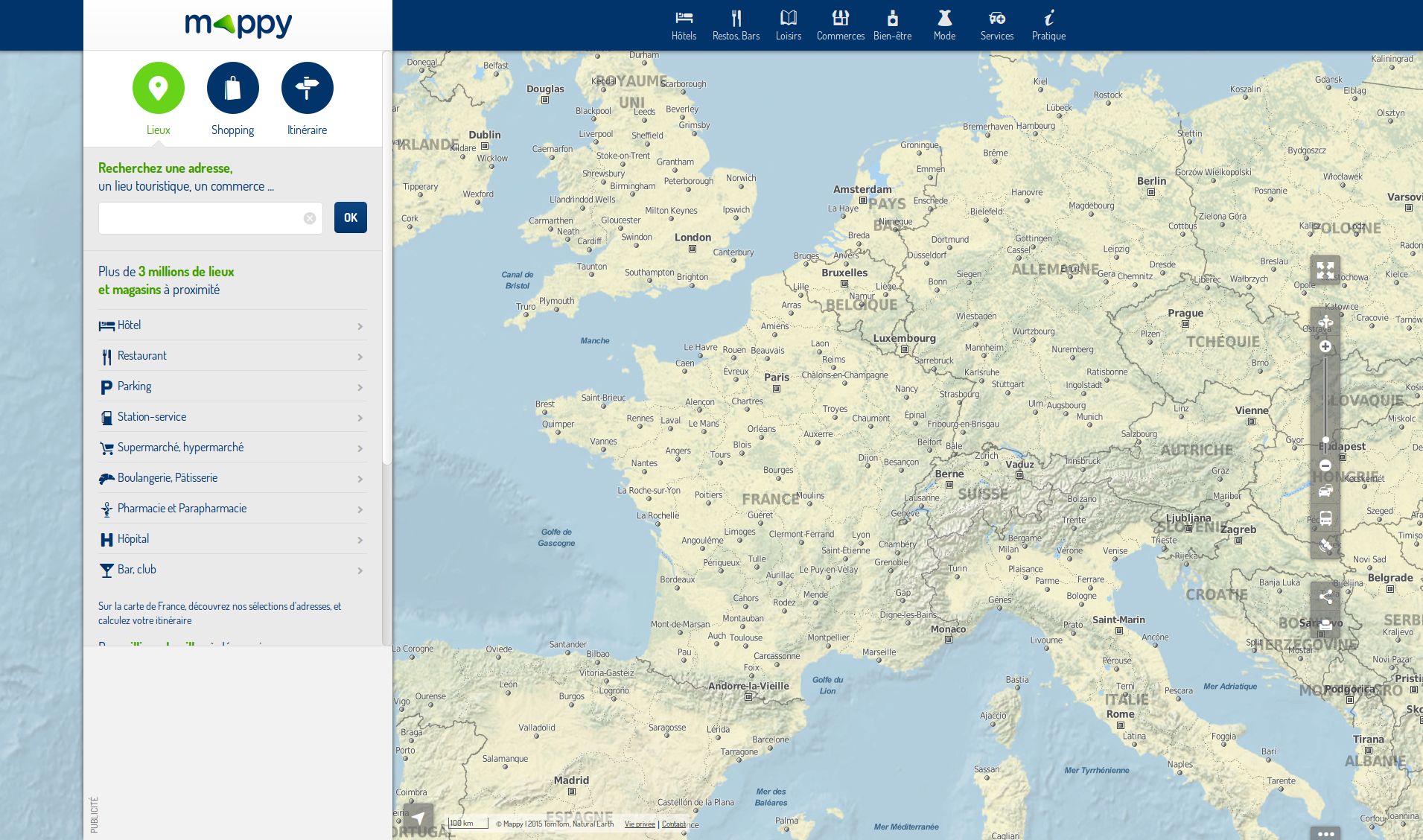

Google préfère un site en HTTPS.
Sans HTTPS, Firefox et Chrome (50) bloquent certaines API JavaScript :
fullscreen,
geolocation,
service worker,
device motion / orientation,
getUserMedia,
encrypted Media Extensions, ...
Apple force HTTPS avec AppTransportSecurity depuis iOS 9.0 et OS X v10.11.
It looks like major browsers (Firefox & Chrome) may be limiting the HTTP/2 support for TLS connections only, in order to push for a more secure web (SSL/TLS everywhere).
Dire que vous vous n'en avez rien à faire de la vie privée parce que vous n'avez rien à cacher, c'est comme dire que vous n'en avez rien à faire de la liberté d'expression parce que vous n'avez rien à dire.

$ echo -n "Hello World" | sha1sum
0a4d55a8d778e5022fab701977c5d840bbc486d0
$ echo -n "Hello World." | sha1sum
b701146cf2c1262a6385c8b1fb1db98f05820499
$ sha1sum ubuntu-12.04.3-desktop-amd64.iso
0c06d876dabb4403cede1245e3b0bf1d81afd497
MD5, SHA-1, SHA-2 (SHA-224, SHA-256, SHA-384 et SHA-512), SHA3.
Influencé par une clé
echo -n "Hello World" | openssl dgst -sha1 -hmac "key"
cc24f1acdb06cf429bcf9861b6d708b6ec20a8fa
Permet de vérifier l’intégrité des données.
HMAC_MD5, HMAC_SHA1, HMAC_SHA256.


en clair
TCP 443
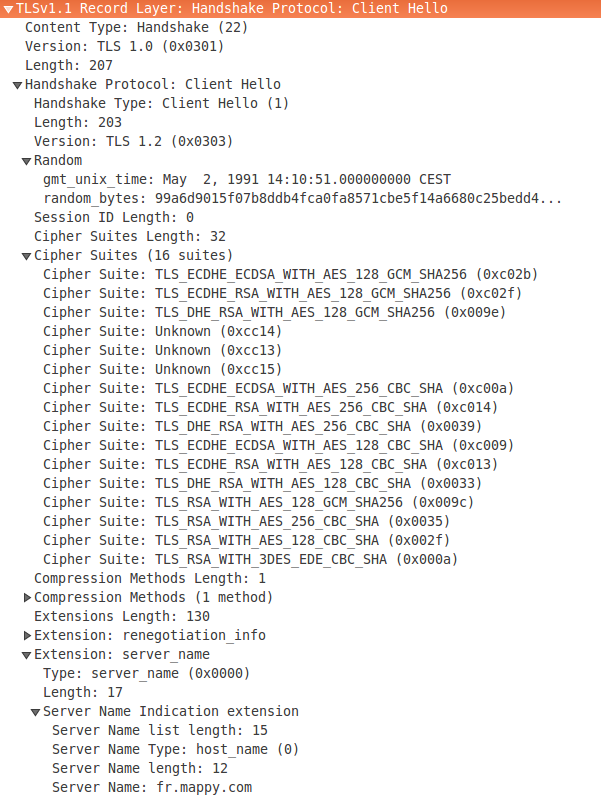
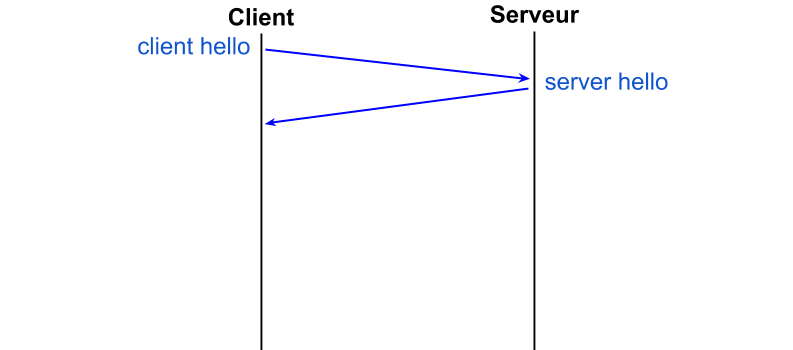
en clair
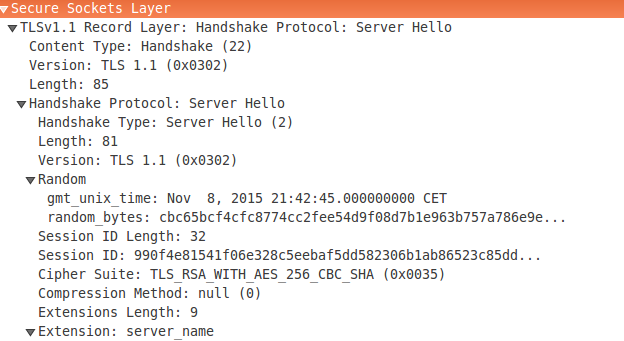
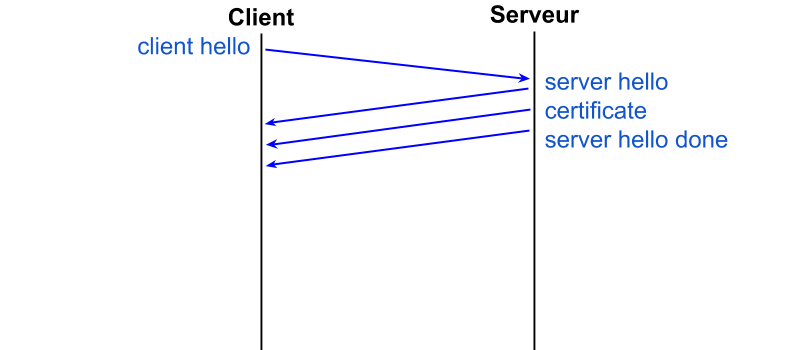
en clair

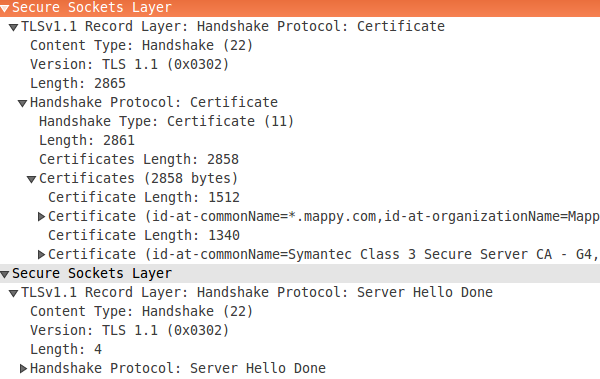
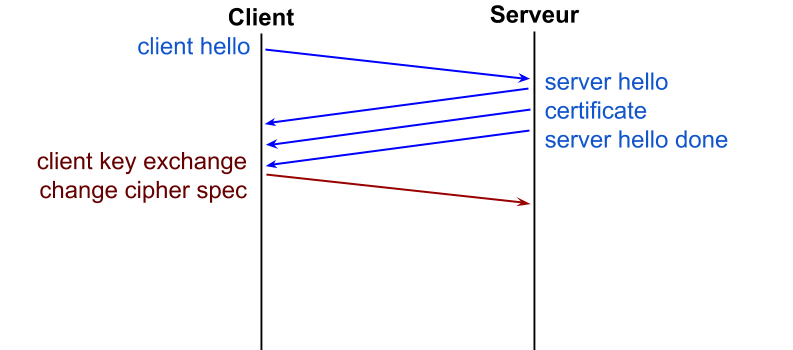
chiffrement asymétrique
preMasterSecret = random()
encrypt(certicate.publicKey, preMasterSecret)
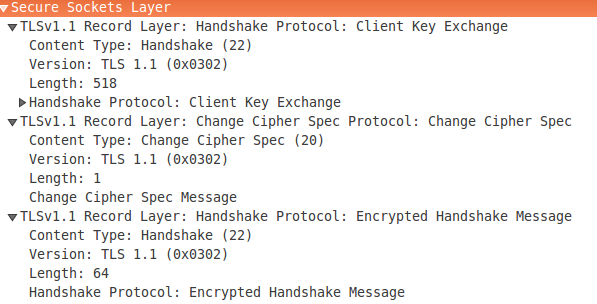
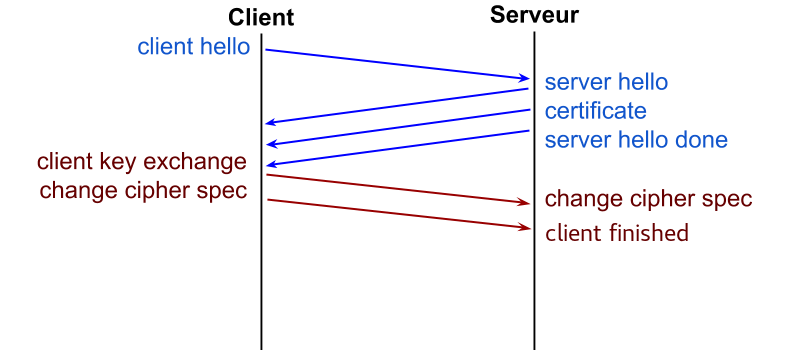
chiffrement asymétrique
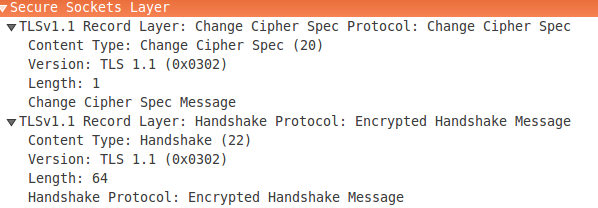
ms = PRF(client.preMasterSecret, client.random, server.random)
// ms = masterSecret
[ clientCipherKey, serverCipherKey ] = extractCipherKeys(ms)
[ clientHMACKey, serverHMACKey ] = extractHMACKeys(ms)
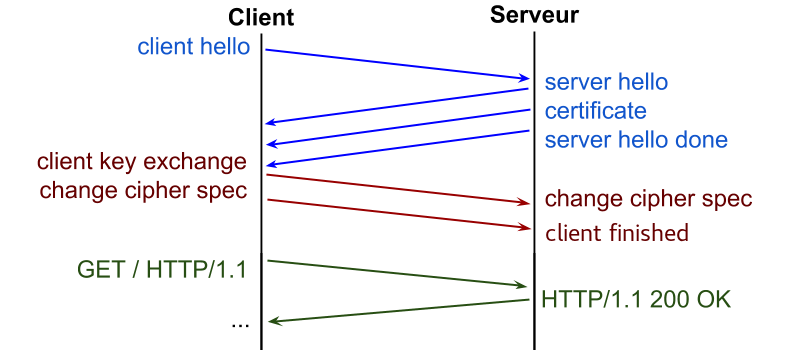
chiffrement symétrique

encrypt(request, clientCipherKey, clientHMACKey) // client
decrypt(request, clientCipherKey, clientHMACKey) // server
encrypt(response, serverCipherKey, serverHMACKey) // server
decrypt(response, serverCipherKey, serverHMACKey) // client
Échange de clé, authentication (asymétrique), chiffrement (symétrique), MAC/HMAC
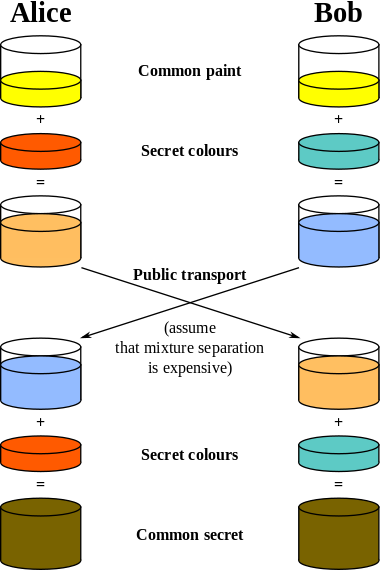
La conversation reste secrête même si la clé privée a fuité grâce à l’échange de clés Diffie-Hellman.
Suites "Ephemeral Diffie-Hellman" : DHE-RSA-AES128-SHA, EDH-RSA-DES-CBC-SHA, ECDHE-RSA-AES128-SHA, ...
La poignée de main est légèrement différente.

$ openssl x509 -in GandiStandardSSLCA2.pem -inform pem -noout -text
Certificate:
Data:
Version: 3 (0x2)
Serial Number: 05:e4:dc:3b:94:38:ab:3b:85:97:cb:a6:a1:98:50:e3
Signature Algorithm: sha384WithRSAEncryption
Issuer: C=US, ST=New Jersey, L=Jersey City, O=The USERTRUST Network, CN=USERTrust RSA Certification Authority
Validity Not Before: Sep 12 00:00:00 2014 GMT Not After : Sep 11 23:59:59 2024 GMT
Subject: C=FR, ST=Paris, L=Paris, O=Gandi, CN=Gandi Standard SSL CA 2
Subject Public Key Info:
Public Key Algorithm: rsaEncryption
Public-Key: (2048 bit)
Modulus: 00:94:04:2d:a6:79:95:74:ff:d5:00:3c:f5:ae:d8:...
Exponent: 65537 (0x10001)
X509v3 extensions:
X509v3 Authority Key Identifier:
keyid:53:79:BF:5A:AA:2B:4A:CF:54:80:E1:D8:9B:C0:9D:F2:B2:03:66:CB
X509v3 Subject Key Identifier:
B3:90:A7:D8:C9:AF:4E:CD:61:3C:9F:7C:AD:5D:7F:41:FD:69:30:EA
X509v3 Key Usage: critical
Digital Signature, Certificate Sign, CRL Sign
X509v3 Basic Constraints: critical
CA:TRUE, pathlen:0
X509v3 Extended Key Usage:
TLS Web Server Authentication, TLS Web Client Authentication
X509v3 Certificate Policies:
Policy: 1.3.6.1.4.1.6449.1.2.2.26
Policy: 2.23.140.1.2.1
X509v3 CRL Distribution Points:
Full Name: URI:http://crl.usertrust.com/USERTrustRSACertificationAuthority.crl
Authority Information Access:
CA Issuers - URI:http://crt.usertrust.com/USERTrustRSAAddTrustCA.crt
OCSP - URI:http://ocsp.usertrust.com
Signature Algorithm: sha384WithRSAEncryption
58:67:fd:72:b2:6a:d7:7c:61:96:19:7e:d9:43:46:d1:26:7d:...
Autorité de certification + Protocole ACME + Agent OSS = Certificat DV à jour
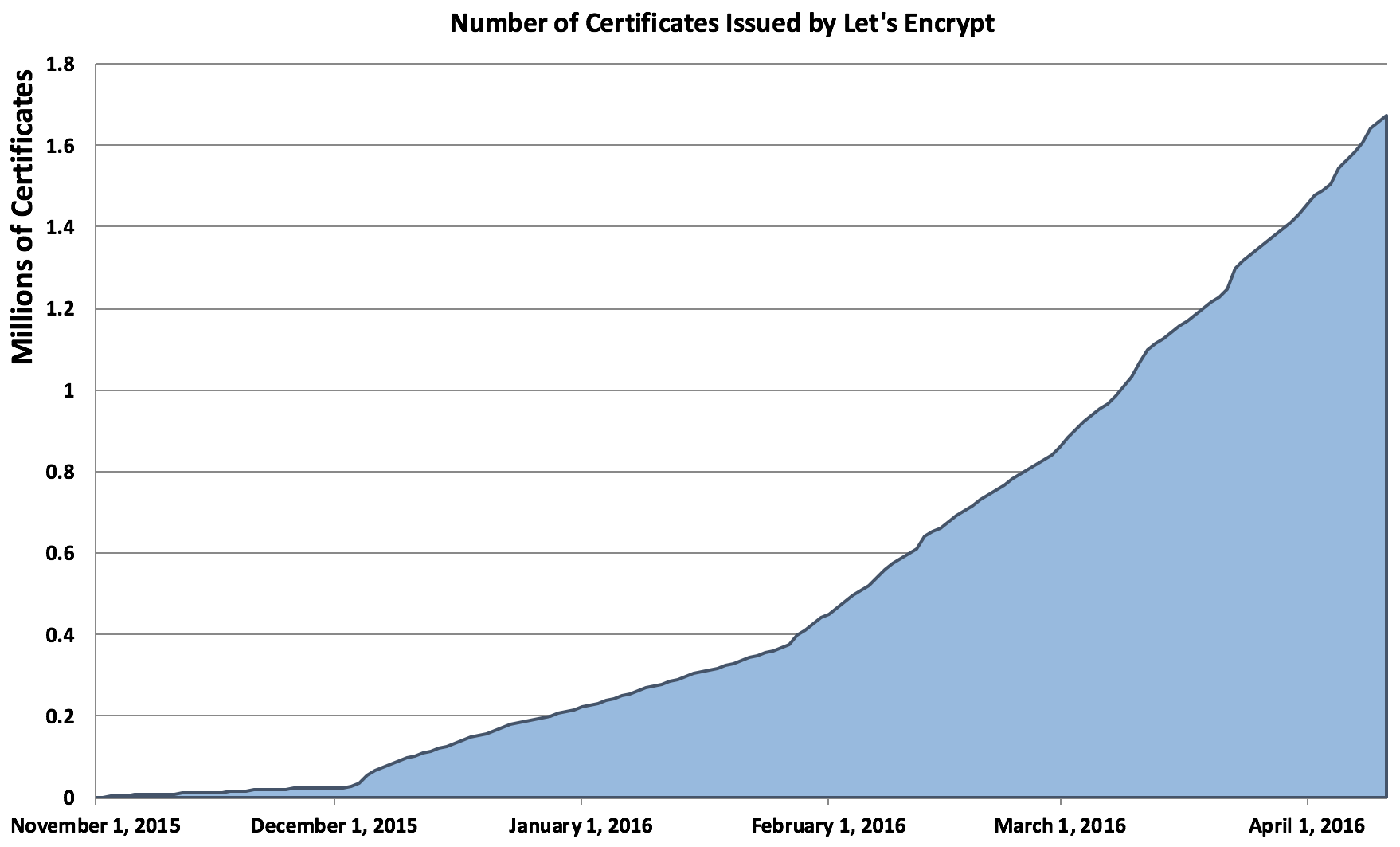
filtre les domaines (Safe Browsing API) et soumission dans Certificate Transparency

Can the NSA break AES? My guess is that they can't.
Still, I trust the mathematics.

Encryption works. Properly implemented strong crypto systems are one of the few things that you can rely on. Unfortunately, endpoint security is so terrifically weak that NSA can frequently find ways around it.
| type | algo | crack | et aujourd’hui ? |
|---|---|---|---|
| RSA 512 | 1999 | entre 7 heures et 2,5 jours via EC2 | |
| RSA 768 | 2009 | ||
| RSA 1024 | 1 an via Conficker (9~15M PC, 100 000 $ à la clé) | ||
| RSA 2048 | 232 plus (200 000 $ à la clé) | ||
| DES 56 | 1997 | < 24 heures | |
| AES 128 | (2304 bits) | avec 1 000 000 000 PC, 660 x l’age de l’univers | |
| AES 256 | 8 octodecillion $ (ou 1044 le PIB mondial) |


<img>, <audio>, <video>
<script>, <link>, <iframe>, <object>, XMLHttpRequest, propriétés CSS
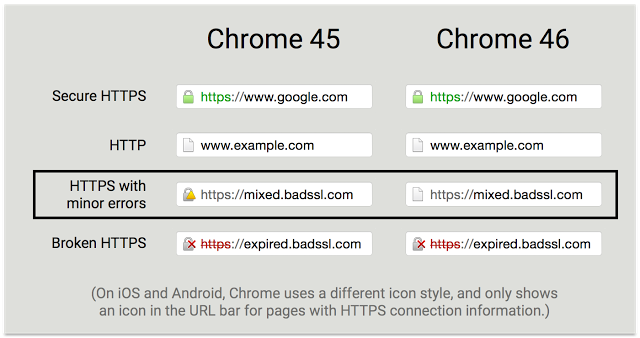
Strict-Transport-Security: max-age=16070400; includeSubDomainshttps:// (même si l’utilisateur tape http:// ou si les liens pointent vers http://),
example.com. IN CAA 0 issue "letsencrypt.org"
example.com. IN CAA 0 iodef "mailto:[email protected]"
example.com. IN CAA 128 future "digicert.com"
<script src="https://example.com/jquery.js"
integrity="sha384-oqVuAfX542FR..."><script>
Content-Security-Policy:default-src 'none';
script-src 'self'; style-src 'self';
upgrade-insecure-requests; block-all-mixed-content;
report-uri (il existe des générateurs de CSP)
Feature-Policy: vibrate 'none'; speaker *;
geolocation 'self' https://example.comgeolocation,
midi,
notifications,
push,
vr,
usb,
sync-xhr,
microphone,
camera,
magnetometer,
gyroscope,
speaker,
vibrate,
fullscreen,
payment,
...
),
iframe,
SSL/TLS accounts for less than 1% of the CPU load, less than 10KB of memory per connection and less than 2% of network overhead
We have found that modern software-based TLS implementations running on commodity CPUs are fast enough to handle heavy HTTPS traffic
Pour tester le nombre de "poignées de main/seconde" :
$ openssl speed rsaSur ce Thinkpad t440s (fin 2013 - Intel Core i7-4600U @ 2.10GHz) :
sign verify sign/s verify/s
rsa 512 bits 0.000051s 0.000005s 19514.8 220139.1
rsa 1024 bits 0.000193s 0.000013s 5182.2 79873.9
rsa 2048 bits 0.001312s 0.000040s 762.3 25034.3
rsa 4096 bits 0.009250s 0.000145s 108.1 6889.3
Facteur 7 entre 1024 et 2048, 2048 et 4096




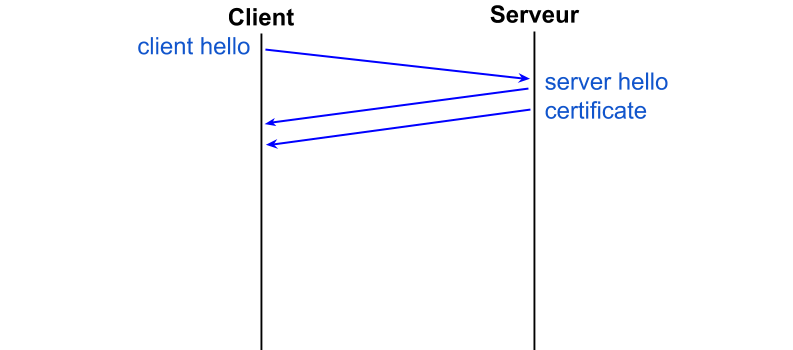


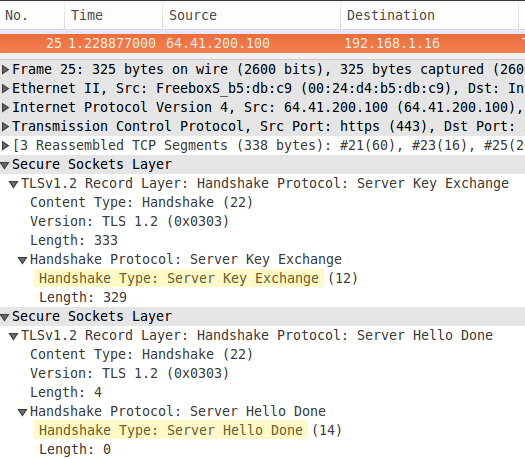





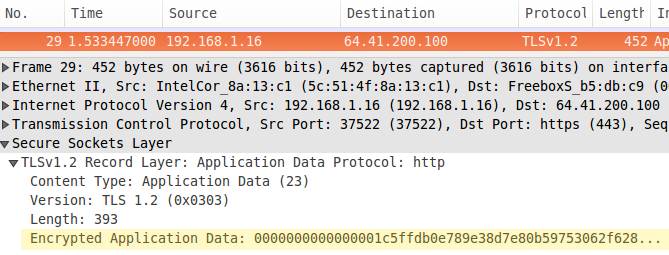
TLSA,
export RSA),
DHE en DHE_EXPORT (512 bits),
ECDHE.
Public-Key-Pins: pin-sha256=""; pin-sha256=""; max-age=259200Public-Key-Pins-Report-Only: report-uri